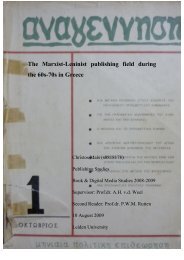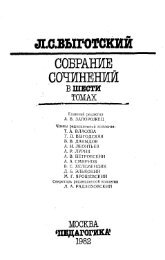You also want an ePaper? Increase the reach of your titles
YUMPU automatically turns print PDFs into web optimized ePapers that Google loves.
54 SOVIET RUSSIA PICTORIAL March, 1923<br />
From the Pacific to the White Sea<br />
THE DEPARTURE: at the Astoria, Oregon, railroad station.<br />
By GEORGE HALONEN<br />
(Soviet Karelian Representative in America)<br />
LAST June a group of about one<br />
hundred Finnish-American fishermen<br />
and their families left Astoria, Oregon,<br />
. for Soviet Karelia, the Northwestern<br />
corner of Soviet Russia .which<br />
lies between White Finland and the<br />
White Sea. Their representatives had<br />
previously selected Knaso, or Knasnaja<br />
Guba, a little village on the White Sea,<br />
as the, settling place for the American<br />
group. Immediately after their arrival<br />
the colonists began to construct for<br />
themselves homes, a community house<br />
(the Finns cannot live without their<br />
own community house, be it in America<br />
or anywhere else) .and buildings for a<br />
modern canning plant.<br />
The White Sea is very rich in fish,<br />
abounding in salmon, sea trout, herring,<br />
but as an industry fishing has heretofore<br />
been on a very primitive basis. Modern<br />
methods in fishing and in preserving the<br />
catch are unknown. Thus Northern<br />
Russia, in spite of its own plentiful resources,<br />
has been compelled to buy fish<br />
from Norway and other countries to<br />
satisfy its own needs.<br />
When Karelia was freed from the<br />
White Finns and other counter-revolutionary<br />
elements, it remained in close<br />
connection with Soviet Russia although<br />
retaining autonomy in its internal affairs.<br />
Finnish revolutionists gave their<br />
energies to reconstruction of the country.<br />
The economic life of Karelia is<br />
slowly but surely being restored from<br />
the ruins of the many wars. In the plans<br />
for reconstruction was included the<br />
problem of developing the fishing industry.<br />
As Finnish-American workers<br />
were also interested in this task, a Cooperative<br />
Fishermen's Group was formed<br />
in Astoria, Ore., a year ago by Finns on<br />
the Pacific coast for the purpose of organizing<br />
this industry in Karelia.<br />
Complete first class American canmaking<br />
and fish-canning machines were<br />
bought and shipped last summer. At<br />
present the machinery is already being<br />
installed. This cannery will furnish fish<br />
not only for Karelia, but for Petrograd<br />
and other Russian cities as well.<br />
The co-operative group made an<br />
agreement with the Karelian Soviets<br />
whereby a state fish trust was formed.<br />
The Americans are managers of this<br />
trust and work in close co-operation with<br />
the government. The plans are to teach<br />
Karelian and Russian fishermen new<br />
methods in their occupation and to build<br />
a strong fishing industry comprising not<br />
only the White Sea, but also the coast<br />
of Murmansk.<br />
Working in conjunction with the fishing<br />
colony is also a group of ten Finnish<br />
- American carpenters who dim<br />
to show new construction methods to<br />
the natives and to build new houses for<br />
those of them who will be drawn to the<br />
fishing industry around the cannery. An<br />
old saw mill has been given to this group<br />
and will form the basis for preparation<br />
of building materials. A barrel factory<br />
HBBBBI<br />
THE ARRIVAL: working at Krasnaya Cuba in Soviet Karelia.<br />
will also be erected in connection with this<br />
mill.<br />
The first and biggest difficulties have been<br />
overcome and the colonists hope to be able<br />
to raise the fishing industry considerably<br />
during the next summer already. Although<br />
so far they have been compelled to give<br />
most of their attention to preliminary work,<br />
a few carloads of salted fish have already<br />
been sent to Petrozavodsk, the capital, creating<br />
much surprise on account of the fine<br />
taste of the fish, the salting being done in a<br />
modern way not known there before, and<br />
because such results were not expected in so<br />
short a time.<br />
These American pioneers hope to gain the<br />
confidence of the native population, to draw<br />
them into the new industry and thereby to<br />
be of great service in the general reconstruction<br />
of Soviet Russia.<br />
The Conference for Proletarian Rel ef<br />
(The report below deals with the opening<br />
sessions of the conference, January 18-20.<br />
A more exhaustive account will be given in<br />
a subsequent issue.—ED.)<br />
FROM all over the world the scattered<br />
members of the executive committee<br />
of the International • Workers' Relief<br />
came into Berlin, and so few stayed away<br />
that from a committee meeting the occasion<br />
turned into a miniature congress.<br />
Among the working - class relief groups<br />
which constitute this International and<br />
which were represented at the conference<br />
were those from England, France,<br />
Italy, Switzerland, Austria, Czecho-Slovakia,<br />
Holland, Norway, Sweden, Germany,<br />
Russia, Japan and the United<br />
States. ' World renowned figures were<br />
plentiful, including Katayama, Rolland<br />
Hoist, Martin Andersen - Nexo, Kameneva,<br />
Edgar T. Whitehead, Clara Zetkin,<br />
Antonio Bombacci, Arthur Holitscher.<br />
Willi Miinzenberg, general secretary<br />
of the International Workers' Relief, opened<br />
the conference and introduced the Russian<br />
ambassador in Berlin, Comrade Krestinsky,<br />
who greeted the delegates in the<br />
name of the Soviet Government. He was<br />
followed by Kameneva, who spoke in behalf<br />
of the Commission for Fighting the<br />
Consequences of the Famine.<br />
Succinctly she outlined the economic<br />
situation which forced Russia to depend<br />
on outsiders for help in the famine period.<br />
The overwhelming loss of agricultural<br />
implements and draught animals, she<br />
showed, made it impossible for the peasants<br />
to take advantage of the better conditions<br />
after the famine. In consequence,<br />
a lack of about 100 million poods of grain<br />
still exists. She quoted Nansen to the effect<br />
that in ten Provinces investigated<br />
there were 5 million children and 3J4<br />
million adults in fteed of assistance; an<br />
improvement over last year, indeed, yet<br />
a serious menace.<br />
Kameneva discussed in detail the orphans'<br />
situation. There are now 11,710<br />
Children's Homes, caring for 830,000 boys<br />
and girls. But these homes are sadly in<br />
need of supplies, and sometimes of food.<br />
What is more, they care for but a fraction<br />
of those in need of aid. A whole<br />
generation is threatened with extinction,<br />
she declared, and the working class in all<br />
countries must try to save as many of<br />
these children as possible.<br />
Other reports followed, delegations<br />
from various countries rendering detailed<br />
accounts of work accomplished. After<br />
these preliminaries, the conference will plan<br />
activities for the next season, with particular<br />
reference to increased assistance<br />
for the destitute children.















![tyf Enf=O=n]lgg](https://img.yumpu.com/47584932/1/190x245/tyf-enfonlgg.jpg?quality=85)

